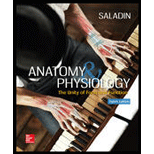
Which of these is caudal to the hypothalamus?
- a. the thalamus
- b. the optic chiasm
- c. the cerebral aqueduct
- d. the pituitary gland
- e. the corpus callosum
Introduction:
The brain is a vital organ of humans where all the life activities are processed and communicated to all parts of the body. The rostral region and caudal region represent the direction of the brain. The rostral region represents the direction towards the face, and the caudal region is the direction that represents the tail region of the brain. The cerebral aqueduct is a part of the brain ventricular system which connects the third ventricle present in the diencephalon and the fourth ventricle present in the brain stem.
Answer to Problem 1TYR
Correct answer:
The cerebral aqueduct is caudal to the hypothalamus. Therefore, option cis correct.
Explanation of Solution
Justify the reasons for the correct statement:
The cerebral aqueduct helps to connect the third and fourth ventricles of the brain ventricular system. It is just caudal to the hypothalamus, in the midbrain, and travels through the cerebral aqueduct canal. It divides the dorsal side and ventral side of the brain.
Option (c) is given as, “the cerebral aqueduct”.
The cerebral aqueduct is a connecting duct that passes from the third ventricle to the fourth ventricle. It is present just behind the hypothalamus.
Hence, option (c)is correct.
Justify the reasons for the incorrect statements:
Option (a) is given as, “the thalamus”.
The thalamus is surrounded by the third ventricle and is situated at the top of the brain stem. It is differentiated from the diencephalon during embryonic development.Hence, it is a wrong answer.
Option (b) is given as, “the optic chiasm”.
The optic chiasm is present below the hypothalamus; it is located at the bottom of the brain.Hence, it is a wrong answer.
Option (d) is given as, “pituitary gland”.
The pituitary gland is the master gland of the endocrine system, which is located at the bottom of the hypothalamus. Hence, it is a wrong answer.
Option (e) is given as, “the corpus callosum”.
The two cerebral hemispheres are divided into right and left hemispheres. These hemispheres are separated by a thick band of nerves known as the corpus callosum. Hence, it is a wrong answer.
Hence, options (a), (b), (d), and (e) are incorrect.
The brain has four ventricles that are considered as internal chambers. Four ventricles are connected to each other by the canals. One of the canals is situated just behind the hypothalamus or the caudal region of the hypothalamus.
Want to see more full solutions like this?
Chapter 14 Solutions
Anatomy & Physiology: The Unity of Form and Function
Additional Science Textbook Solutions
Human Physiology
Concepts of Biology
Marine Biology (Botany, Zoology, Ecology and Evolution)
Microbiology: Principles and Explorations
Microbiology: Principles and Explorations
Campbell Biology in Focus (2nd Edition)
- The integration of the internal activities of the body is controlled by thea. cerebrum.b. cerebellum.c. hypothalamus.d. brain stem.arrow_forwardWhich statement is true? A. the pituitary glands dngles from the hypothalamus by the infundibulum B. The post-central gyrus houses the primary motor cortex C. The thalamus surround third ventricle D. White matter consists of myelinated axons of neuronsarrow_forwardAll of the following are functions of the hypothalamus except a. controls endocrine system. b. regulates sleep-wake cycle. c. controls autonomic nervous system. d. initiates voluntary skeletal muscle movement.arrow_forward
- A person catching a ball must coordinate her head and eyes. What part of the brain is helping to do this? a. hypothalamus b. pineal gland c. thalamus d. superior colliculusarrow_forwardWhich of these statements about the basal nuclei is true?a. They are located in the cerebrum.b. They contain the caudate nucleus.c. They are involved in motor control.d. They are part of the extrapyramidal system.e. All of these are true.arrow_forwardname the structure the arrow is pointed at. a. thalamus b. head of caudate nucleus c. Putamen d. internal capsule E. Global pallidusarrow_forward
- All of the following statements are accurate about the choroid plexus except a. it is located within the ventricles of the brain. b. it is composed of ependymal cells and blood capillaries. c. it receives and filters all sensory information. d. it produces and circulates cerebrospinal fluid.arrow_forwardSympathetic nerve stimulation does not causea. the liver to release glycogen.b. the dilation of bronchioles.c. the gastrointestinal tract to digest food.d. an increase in the heart rate.arrow_forwardMaria often sleeps soundly and rarely awakens to any outside noise. However, the cries of Maria’s baby can awaken her immediately. What part of the brain is responsible for this reaction? a. medulla c. reticular formation b. pons d. cerebellumarrow_forward
- The largest, outermost portion of the brain in humans is thea. cerebellum. c. reticular activating system.b. cerebrum. d. thalamus.arrow_forwardWhich of the following brain regions is not correctly matched to itsfunction?a. The medulla oblongata regulates heartbeat, breathing, and bloodpressure.b. The cerebellum coordinates voluntary muscle movements.c. The thalamus secretes melatonin, which regulates daily bodyrhythms.d. The midbrain acts as a refl ex center for visual, auditory, andtactile responses.arrow_forwardWhich of the following is part of the ventricular system associated with the mesencephalon? a. fourth ventricle b. third ventricle c. subarachnoid space d. cerebral aqueduct d. lateral ventriclearrow_forward
 Fundamentals of Sectional Anatomy: An Imaging App...BiologyISBN:9781133960867Author:Denise L. LazoPublisher:Cengage LearningEssentials of Pharmacology for Health ProfessionsNursingISBN:9781305441620Author:WOODROWPublisher:Cengage
Fundamentals of Sectional Anatomy: An Imaging App...BiologyISBN:9781133960867Author:Denise L. LazoPublisher:Cengage LearningEssentials of Pharmacology for Health ProfessionsNursingISBN:9781305441620Author:WOODROWPublisher:Cengage Comprehensive Medical Assisting: Administrative a...NursingISBN:9781305964792Author:Wilburta Q. Lindh, Carol D. Tamparo, Barbara M. Dahl, Julie Morris, Cindy CorreaPublisher:Cengage Learning
Comprehensive Medical Assisting: Administrative a...NursingISBN:9781305964792Author:Wilburta Q. Lindh, Carol D. Tamparo, Barbara M. Dahl, Julie Morris, Cindy CorreaPublisher:Cengage Learning




